An In Silico Investigation to Explore Anti-Cancer Potential of Foeniculum vulgare Mill. Phytoconstituents for the Management of Human Breast Cancer
Abstract
:1. Introduction
2. Results
2.1. Molecular Docking of Major Phytoconstituents of Foeniculum vulgare with Breast Cancer Target
2.2. Drug Likeness Prediction of Foeniculum vulgare Phytoconstituents
2.3. Toxicity Prediction of Foeniculum vulgare Phytoconstituents
2.4. Molecular Dynamic simulation of Complexes
3. Discussion
4. Materials and Methods
4.1. Bioinformatics Tools
4.2. Ligand Preparation
4.3. Protein Preparation
4.4. Molecular Docking of Major Phytoconstituents of Foeniculum vulgare with Breast Cancer Target
4.5. Drug Likeness Prediction of Foeniculum vulgare Phytoconstituents
4.6. Toxicity Prediction of F. vulgare Phytoconstituents by Protox II Server
4.7. MD Simulation of Best Protein-Ligands Complexes
5. Conclusions
Author Contributions
Funding
Institutional Review Board Statement
Informed Consent Statement
Data Availability Statement
Acknowledgments
Conflicts of Interest
Sample Availability
References
- Badgujar, S.B.; Patel, V.V.; Bandivdekar, A.H. Foeniculum vulgare Mill: A review of its botany, phytochemistry, pharmacology, contemporary application, and toxicology. BioMed Res. Int. 2014, 2014, 842674. [Google Scholar] [CrossRef] [PubMed] [Green Version]
- Kooti, W.; Moradi, M.; Ali-Akbari, S.; Sharafi-Ahvazi, N.; Asadi-Samani, M.; Ashtary-Larky, D. Therapeutic and pharmacological potential of Foeniculum vulgare Mill: A review. J. HerbMed Pharmacol. 2015, 4, 1–9. [Google Scholar]
- Rather, M.A.; Dar, B.A.; Sofi, S.N.; Bhat, B.A.; Qurishi, M.A. Foeniculum vulgare: A comprehensive review of its traditional use, phytochemistry, pharmacology, and safety. Arab. J. Chem. 2016, 9, S1574–S1583. [Google Scholar] [CrossRef] [Green Version]
- Hinnebusch, B.F.; Meng, S.; Wu, J.T.; Archer, S.Y.; Hodin, R.A. The Effects of Short-Chain Fatty Acids on Human Colon Cancer Cell Phenotype Are Associated with Histone Hyperacetylation. J. Nutr. 2002, 132, 1012–1017. [Google Scholar] [CrossRef] [PubMed] [Green Version]
- Den Hartigh, L.J. Conjugated Linoleic Acid Effects on Cancer, Obesity, and Atherosclerosis: A Review of Pre-Clinical and Human Trials with Current Perspectives. Nutrients 2018, 11, 370. [Google Scholar] [CrossRef] [PubMed] [Green Version]
- Li, S.; Zhou, T.; Li, C.; Dai, Z.; Che, D.; Yao, Y.; Li, L.; Ma, J.; Yang, X.; Gao, G. High Metastaticgastric and Breast Cancer Cells Consume Oleic Acid in an AMPK Dependent Manner. PLoS ONE 2014, 9, e97330. [Google Scholar] [CrossRef]
- Jiang, L.; Wang, W.; He, Q.; Wu, Y.; Lu, Z.; Sun, J.; Liu, Z.; Shao, Y.; Wang, A. Oleic acid induces apoptosis and autophagy in the treatment of Tongue Squamous cell carcinomas. Sci. Rep. 2017, 7, 1–11. [Google Scholar] [CrossRef] [Green Version]
- Matta, M.; Deubler, E.; Chajès, V.; Gunter, M.; Murphy, N.; Gaudet, M.M. Abstract LB079: Circulating plasma phospholipid fatty acid levels & breast cancer risk in the CPS-II Nutrition Cohort. Epidemiology 2021, 81, LB079. [Google Scholar] [CrossRef]
- Xu, C.; Wu, P.; Gao, J.; Zhang, L.; Ma, T.; Ma, B.; Yang, S.; Shao, G.; Yu, Y.; Huang, X.; et al. Heptadecanoic acid inhibits cell proliferation in PC-9 non-small-cell lung cancer cells with acquired gefitinib resistance. Oncol. Rep. 2019, 41, 3499–3507. [Google Scholar] [CrossRef]
- Ravi, L.; Krishnan, K. Research Article Cytotoxic Potential of N-hexadecanoic Acid Extracted from Kigelia pinnata Leaves. Asian J. Cell Biol. 2017, 12, 20–27. [Google Scholar] [CrossRef] [Green Version]
- Bharath, B.; Perinbam, K.; Devanesan, S.; AlSalhi, M.S.; Saravanan, M. Evaluation of the anticancer potential of Hexadecanoic acid from brown algae Turbinaria ornata on HT–29 colon cancer cells. J. Mol. Struct. 2021, 1235, 130229. [Google Scholar] [CrossRef]
- Arulvasu, C.; Shivaranjani, S.; Revati, M.; Hemavati, M. Free radical scavenging activity and cytotoxic effect of anisaldehyde on human cancer cell line. In International Conference on Advance in New Materials; Department of Inorganic Chemistry, University of Madras: Chennai, India, 2014; Volume 20. [Google Scholar]
- Haghighi, S.R.; Asadi, M.H.; Akrami, H.; Baghizadeh, A. Anti-carcinogenic and anti-angiogenic properties of the extracts of Acorus calamus on gastric cancer cells. Avicenna J. Phytomedicine 2017, 7, 145–156. [Google Scholar] [CrossRef]
- Ding, X.; Chen, H. Anticancer effects of Carvone in myeloma cells is mediated through the inhibition of p38 MAPK signalling pathway, apoptosis induction and inhibition of cell invasion. JBUON 2018, 23, 747–751. [Google Scholar]
- Huang, S.; Wang, L.-L.; Xue, N.-N.; Li, C.; Guo, H.-H.; Ren, T.-K.; Zhan, Y.; Li, W.-B.; Zhang, J.; Chen, X.-G.; et al. Chlorogenic acid effectively treats cancers through induction of cancer cell differentiation. Theranostics 2019, 9, 6745–6763. [Google Scholar] [CrossRef]
- Lashkari, A.; Najafi, F.; Kavoosi, G.; Niazi, S. Evaluating the In vitro anti-cancer potential of estragole from the essential oil of Agastache foeniculum [Pursh.] Kuntze. Biocatal. Agric. Biotechnol. 2020, 27, 101727. [Google Scholar] [CrossRef]
- Zari, A.T.; Zari, T.A.; Hakeem, K.R. Anticancer Properties of Eugenol: A Review. Molecules 2021, 26, 7407. [Google Scholar] [CrossRef]
- Rolim, T.L.; Meireles, D.R.P.; Batista, T.M.; De Sousa, T.K.G.; Mangueira, V.M.; De Abrantes, R.A.; Pita, J.C.L.R.; Xavier, A.L.; Costa, V.C.O.; Batista, L.M.; et al. Toxicity and antitumor potential of Mesosphaerum sidifolium (Lamiaceae) oil and fenchone, its major component. BMC Complementary Altern. Med. 2017, 17, 1–12. [Google Scholar]
- Bayala, B.; Bassole, I.H.N.; Gnoula, C.; Nebie, R.; Yonli, A.; Morel, L.; Figueredo, G.; Nikiema, J.-B.; Lobaccaro, J.-M.A.; Simpore, J. Chemical Composition, Antioxidant, Anti-Inflammatory and Anti-Proliferative Activities of Essential Oils of Plants from Burkina Faso. PLoS ONE 2014, 9, e92122. [Google Scholar] [CrossRef] [Green Version]
- Sun, J. D-Limonene: Safety and clinical applications. Altern. Med. Rev. 2007, 12, 259. [Google Scholar]
- Bai, X.; Tang, J. Myrcene Exhibits Antitumor Activity Against Lung Cancer Cells by Inducing Oxidative Stress and Apoptosis Mechanisms. Nat. Prod. Commun. 2020, 15, 1934578X20961189. [Google Scholar] [CrossRef]
- Aydin, E.; Türkez, H.; Geyikoğlu, F. Antioxidative, anticancer and genotoxic properties of α-pinene on N2a neuroblastoma cells. Biologia 2013, 68, 1004–1009. [Google Scholar] [CrossRef]
- Yamazaki, S.; Miyoshi, N.; Kawabata, K.; Yasuda, M.; Shimoi, K. Quercetin-3-O-glucuronide inhibits noradrenaline-promoted invasion of MDA-MB-231 human breast cancer cells by blocking β2-adrenergic signaling. Arch. Biochem. Biophys. 2014, 557, 18–27. [Google Scholar] [CrossRef]
- Contant, C.; Rouabhia, M.; Loubaki, L.; Chandad, F.; Semlali, A. Anethole induces anti-oral cancer activity by triggering apoptosis, autophagy and oxidative stress and by modulation of multiple signaling pathways. Sci. Rep. 2021, 11, 1–14. [Google Scholar] [CrossRef]
- Hassan, S.B.; Gali-Muhtasib, H.; Göransson, H.; Larsson, R. Alpha terpineol: A potential anticancer agent which acts through suppressing NF-κB signalling. Anticancer Res. 2010, 30, 1911–1919. [Google Scholar]
- Kim, D.-H.; Han, S.-I.; Go, B.; Oh, U.H.; Kim, C.-S.; Jung, Y.-H.; Lee, J.; Kim, J.-H. 2-Methoxy-4-vinylphenol Attenuates Migration of Human Pancreatic Cancer Cells via Blockade of FAK and AKT Signaling. Anticancer Res. 2019, 39, 6685–6691. [Google Scholar] [CrossRef]
- Terasaki, M.; Ito, H.; Kurokawa, H.; Tamura, M.; Okabe, S.; Matsui, H.; Hyodo, I. Acetic acid is an oxidative stressor in gastric cancer cells. J. Clin. Biochem. Nutr. 2018, 63, 36–41. [Google Scholar] [CrossRef] [Green Version]
- A Head, K. Ascorbic acid in the prevention and treatment of cancer. Altern. Med. Rev. 1998, 3, 174–186. [Google Scholar]
- Moayedi, Y.; Greenberg, S.A.; Jenkins, B.A.; Marshall, K.L.; Dimitrov, L.V.; Nelson, A.M.; Owens, D.M.; Lumpkin, E.A. Camphor white oil induces tumor regression through cytotoxic T cell-dependent mechanisms. Mol. Carcinog. 2018, 58, 722–734. [Google Scholar] [CrossRef]
- Al Bratty, M.; Makeen, H.A.; Alhazmi, H.A.; Syame, S.M.; Abdalla, A.N.; Homeida, H.E.; Sultana, S.; Ahsan, W.; Khalid, A. Phytochemical, Cytotoxic, and Antimicrobial Evaluation of the Fruits of Miswak Plant, Salvadora persica L. J. Chem. 2020, 2020, 4521951. [Google Scholar] [CrossRef]
- El-Garawani, I.; El Nabi, S.H.; Nafie, E.; Almeldin, S. Foeniculum vulgare and Pelargonium graveolens Essential Oil Mixture Triggers the Cell Cycle Arrest and Apoptosis in MCF-7 Cells. Anti-Cancer Agents Med. Chem. (Former. Curr. Med. Chem. -Anti-Cancer Agents) 2019, 19, 1103–1113. [Google Scholar] [CrossRef]
- Chiarenza, A.; Scarselli, M.; Novi, F.; Lempereur, L.; Bernardini, R.; Corsini, G.U.; Maggio, R. Apomorphine, dopamine and phenylethylamine reduce the proportion of phosphorylated insulin receptor substrate 1. Eur. J. Pharmacol. 2001, 433, 47–54. [Google Scholar] [CrossRef]
- Khan, A.A.; Alanazi, A.M.; Jabeen, M.; Chauhan, A.; Abdelhameed, A. Design, synthesis and in vitro anticancer evaluation of a stearic acid-based ester conjugate. Anticancer Res. 2013, 33, 2517–2524. [Google Scholar] [PubMed]
- Shahbazian, S.; Akbarzadeh, A.; Torabi, S.; Omidi, M. Anti-cancer activity of pegylated liposomal trans-anethole on breast cancer cell lines MCF-7 and T47D. Biotechnol. Lett. 2015, 37, 1355–1359. [Google Scholar] [CrossRef] [PubMed]
- Ghasemian, A.; Al-Marzoqi, A.-H.; Mostafavi, S.K.S.; Alghanimi, Y.K.; Teimouri, M. Chemical Composition and Antimicrobial and Cytotoxic Activities of Foeniculum vulgare Mill Essential Oils. J. Gastrointest. Cancer 2019, 51, 260–266. [Google Scholar] [CrossRef]
- Mohamad, R.H.; El-Bastawesy, A.M.; Abdel-Monem, M.G.; Noor, A.M.; Al-Mehdar, H.A.R.; Sharawy, S.M.; El-Merzabani, M.M. Antioxidant and Anticarcinogenic Effects of Methanolic Extract and Volatile Oil of Fennel Seeds (Foeniculum vulgare). J. Med. Food 2011, 14, 986–1001. [Google Scholar] [CrossRef]
- Berrington, D.; Lall, N. Anticancer Activity of Certain Herbs and Spices on the Cervical Epithelial Carcinoma (HeLa) Cell Line. Evid.-Based Complement. Altern. Med. 2012, 2012, 1–11. [Google Scholar] [CrossRef] [Green Version]
- Batool, R.; Salahuddin, H.; Mahmood, T.; Ismail, M. Study of anticancer and antibacterial activities of Foeniculum vulgare, Justicia adhatoda and Urtica dioica as natural curatives. Cell. Mol. Biol. 2017, 63, 109–114. [Google Scholar] [CrossRef]
- Zaahkouk, S.M.; Aboul-Ela, E.L.; Ramadan, M.A.; Bakry, S.; Mhany, B.M. Anti-carcinogenic activity of methanolic extract of Foeniculum vulgare seeds (Foeniculum vulgare) against breast, colon, and liver cancer cells. Int. J. Adv. Res. 2015, 3, 1525–1537. [Google Scholar]
- Hossain, A. Molecular Docking, Drug-Likeness and ADMET Analysis, Application of Density Functional Theory (DFT) and Molecular Dynamics (MD) Simulation to the Phytochemicals from Withania Somnifera as Potential Antagonists of Estrogen Receptor Alpha (ER-α). Curr. Comput.-Aided Drug Des. 2021, 17, 797–805. [Google Scholar] [CrossRef]
- Rolta, R.; Salaria, D.; Kumar, V.; Patel, C.N.; Sourirajan, A.; Baumler, D.J.; Dev, K. Molecular docking studies of phytocompounds of Rheum emodi Wall with proteins responsible for antibiotic resistance in bacterial and fungal pathogens: in silico approach to enhance the bio-availability of antibiotics. J. Biomol. Struct. Dyn. 2020, 40, 3789–3803. [Google Scholar] [CrossRef]
- Salaria, D.; Rolta, R.; Patel, C.N.; Dev, K.; Sourirajan, A.; Kumar, V. In vitro and in silico analysis of Thymus serpyllum essential oil as bioactivity enhancer of antibacterial and antifungal agents. J. Biomol. Struct. Dyn. 2021, 16, 1–20. [Google Scholar] [CrossRef]
- Salaria, D.; Rolta, R.; Sharma, N.; Patel, C.N.; Ghosh, A.; Dev, K.; Sourirajan, A.; Kumar, V. In vitro and in silico antioxidant and anti-inflammatory potential of essential oil of Cymbopogon citratus (DC.) Stapf. of North-Western Himalaya. J. Biomol. Struct. Dyn. 2021, 1–15. [Google Scholar] [CrossRef]
- Rolta, R.; Yadav, R.; Salaria, D.; Trivedi, S.; Imran, M.; Sourirajan, A.; Baumler, D.J.; Dev, K. In silico screening of hundred phytocompounds of ten medicinal plants as potential inhibitors of nucleocapsid phosphoprotein of COVID-19: An approach to prevent virus assembly. J. Biomol. Struct. Dyn. 2020, 39, 7017–7034. [Google Scholar] [CrossRef]
- Mehta, J.; Rolta, R.; Salaria, D.; Awofisayo, O.; Fadare, O.A.; Sharma, P.P.; Rathi, B.; Chopra, A.; Kaushik, N.; Choi, E.H.; et al. Phytocompounds from Himalayan Medicinal Plants as Potential Drugs to Treat Multidrug-Resistant Salmonella typhimurium: An In Silico Approach. Biomedicines 2021, 9, 1402. [Google Scholar] [CrossRef]
- Salaria, D.; Rolta, R.; Mehta, J.; Awofisayo, O.; Fadare, O.A.; Kaur, B.; Kumar, B.; da Costa, R.A.; Chandel, S.R.; Kaushik, N.; et al. Phytoconstituents of traditional Himalayan Herbs as potential inhibitors of Human Papillomavirus (HPV-18) for cervical cancer treatment: An In silico Approach. PLoS ONE 2022, 17, e0265420. [Google Scholar] [CrossRef]
- Trott, O.; Olson, A.J. AutoDock Vina: Improving the speed and accuracy of docking with a new scoring function, efficient optimization, and multithreading. J. Comput. Chem. 2010, 31, 455–461. [Google Scholar] [CrossRef] [Green Version]
- Lipinski, C.A. Poor aqueous solubility—an industry wide problem in drug discovery. Am. Pharm. Rev. 2002, 5, 82–85. [Google Scholar]
- Yang, H.; Du, Z.; Lv, W.-J.; Zhang, X.-Y.; Zhai, H.-L. In silico toxicity evaluation of dioxins using structure–activity relationship (SAR) and two-dimensional quantitative structure–activity relationship (2D-QSAR). Arch. Toxicol. 2019, 93, 3207–3218. [Google Scholar] [CrossRef]
- Banerjee, P.; Eckert, A.O.; Schrey, A.K.; Preissner, R. ProTox-II: A webserver for the prediction of toxicity of chemicals. Nucleic Acids Res. 2018, 46, W257–W263. [Google Scholar] [CrossRef] [Green Version]
- Lee, T.-S.; Cerutti, D.S.; Mermelstein, D.; Lin, C.; Legrand, S.; Giese, T.J.; E Roitberg, A.; Case, D.A.; Walker, R.C.; York, D.M. GPU-Accelerated Molecular Dynamics and Free Energy Methods in Amber18: Performance Enhancements and New Features. J. Chem. Inf. Model. 2018, 58, 2043–2050. [Google Scholar] [CrossRef]
- Wang, J.; Wolf, R.M.; Caldwell, J.W.; Kollman, P.A.; Case, D.A. Development and testing of a general amber force field. J. Comput. Chem. 2004, 25, 1157–1174. [Google Scholar] [CrossRef]
- Song, L.F.; Lee, T.S.; Zhu, C.; York, D.M.; Merz, K.M., Jr. Using AMBER18 for relative free energy calculations. J. Chem. Inf. Modeling 2019, 59, 3128–3135. [Google Scholar] [CrossRef]
- Frisch, M.J.; Trucks, G.W.; Schlegel, H.B.; Scuseria, G.E.; Robb, M.A.; Cheeseman, J.R.; Scalmani, G.; Barone, V.; Petersson, G.A.; Nakatsuji, H.; et al. Gaussian 16; Gaussian, Inc.: Wallingford, CT, USA, 2016. [Google Scholar]
- E Frisch, R.; Snow, R.C.; A Johnson, L.; Gerard, B.; Barbieri, R.; Rosen, B. Magnetic resonance imaging of overall and regional body fat, estrogen metabolism, and ovulation of athletes compared to controls. J. Clin. Endocrinol. Metab. 1993, 77, 471–477. [Google Scholar] [CrossRef]
- Ryckaert, J.-P.; Ciccotti, G.; Berendsen, H.J.C. Numerical integration of the cartesian equations of motion of a system with constraints: Molecular dynamics of n-alkanes. J. Comput. Phys. 1977, 23, 327–341. [Google Scholar] [CrossRef] [Green Version]
- Sun, H.; Duan, L.; Chen, F.; Liu, H.; Wang, Z.; Pan, P.; Zhu, F.; Zhang, J.Z.H.; Hou, T. Assessing the performance of MM/PBSA and MM/GBSA methods. 7. Entropy effects on the performance of end-point binding free energy calculation approaches. Phys. Chem. Chem. Phys. 2018, 20, 14450–14460. [Google Scholar] [CrossRef]
- Anza, M.; Endale, M.; Cardona, L.; Cortes, D.; Eswaramoorthy, R.; Zueco, J.; Rico, H.; Trelis, M.; Abarca, B. Antimicrobial Activity, in silico Molecular Docking, ADMET and DFT Analysis of Secondary Metabolites from Roots of Three Ethiopian Medicinal Plants. Adv. Applic. Bioinform. Chem. AABC. 2021, 14, 117. [Google Scholar] [CrossRef]
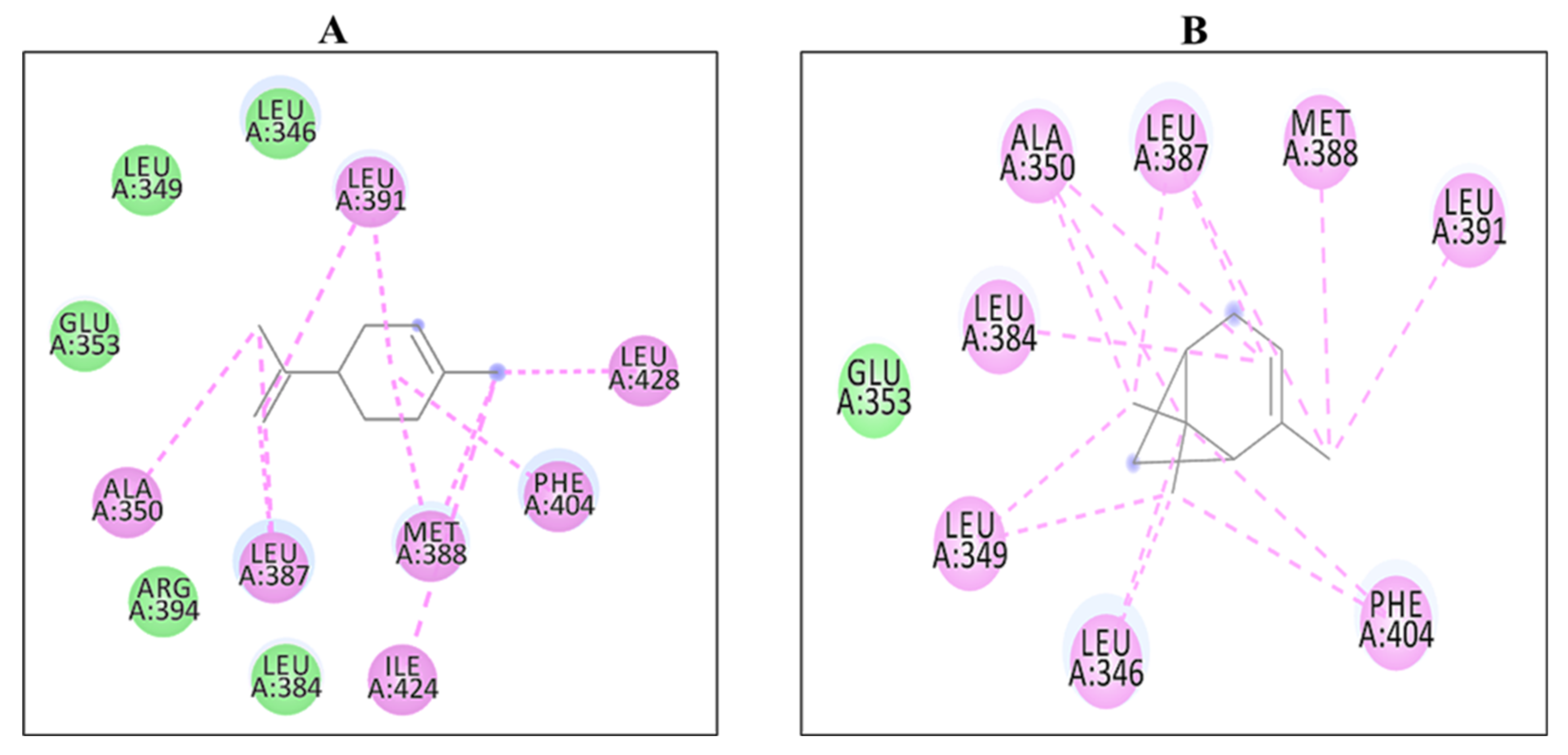
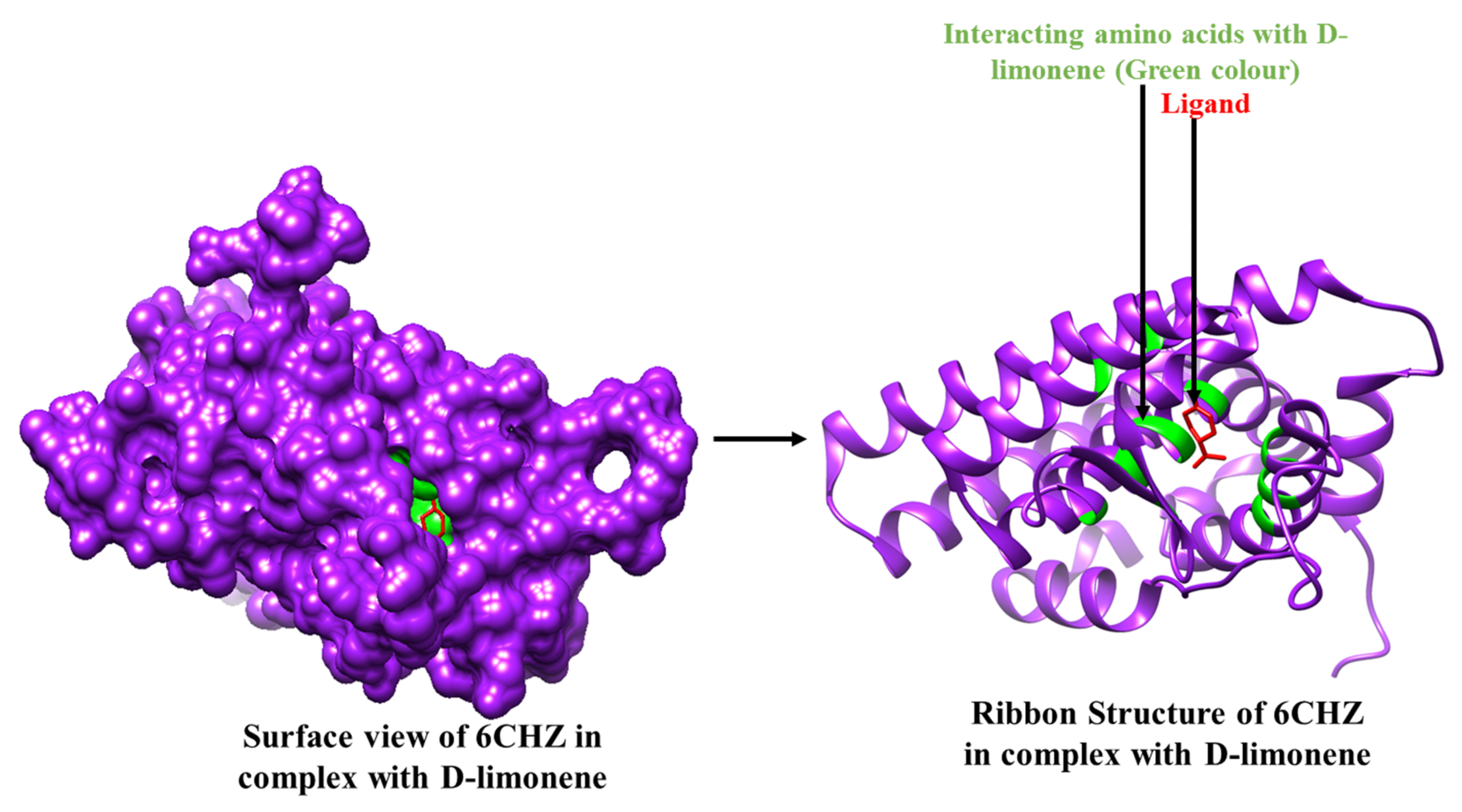
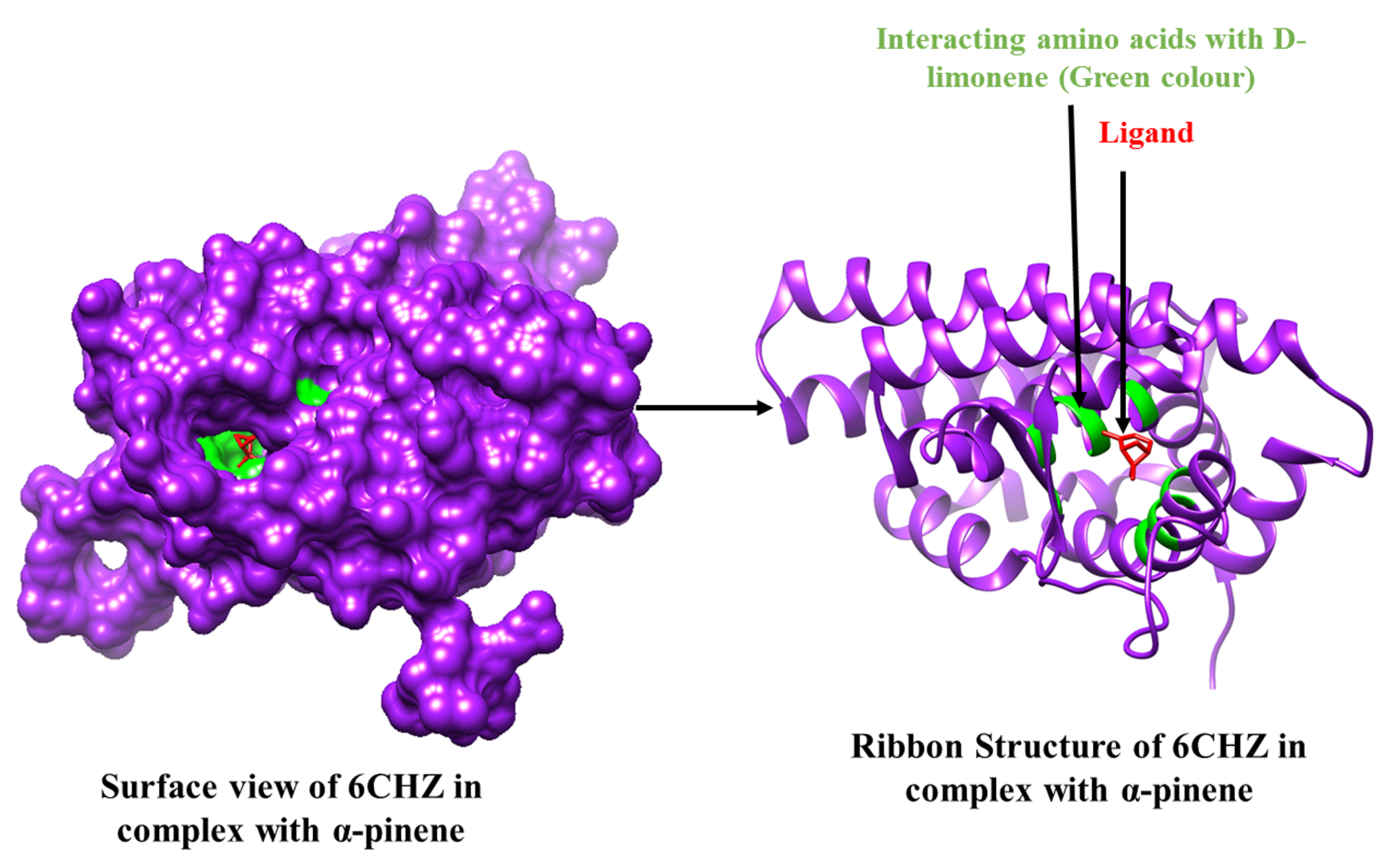
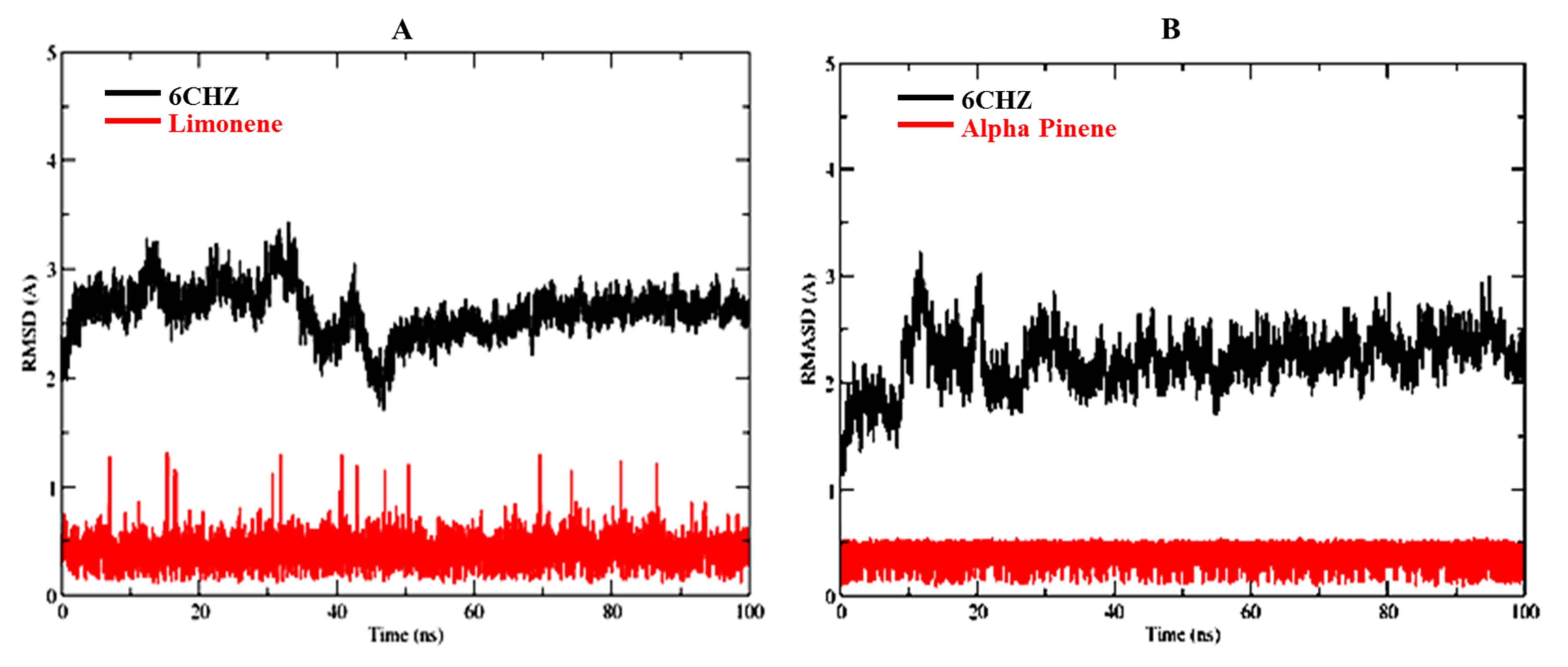
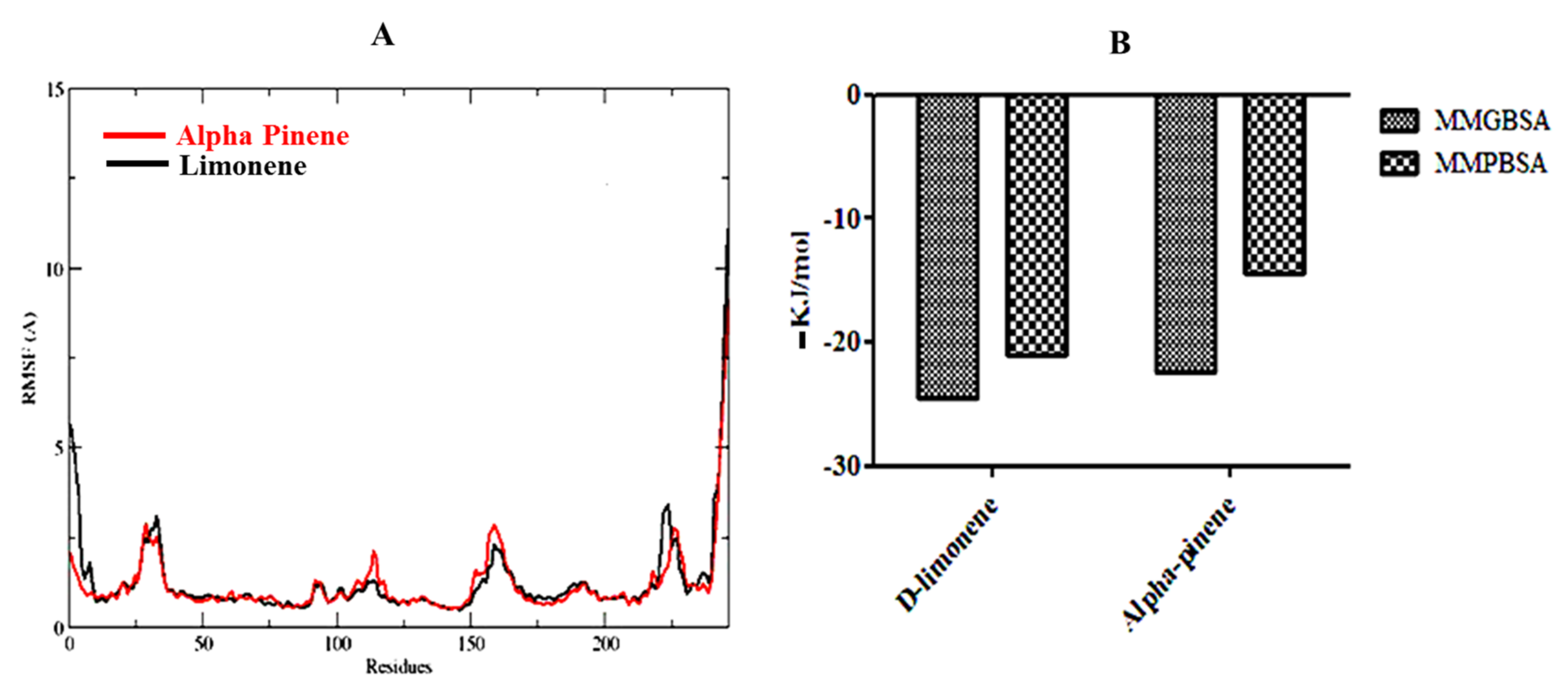
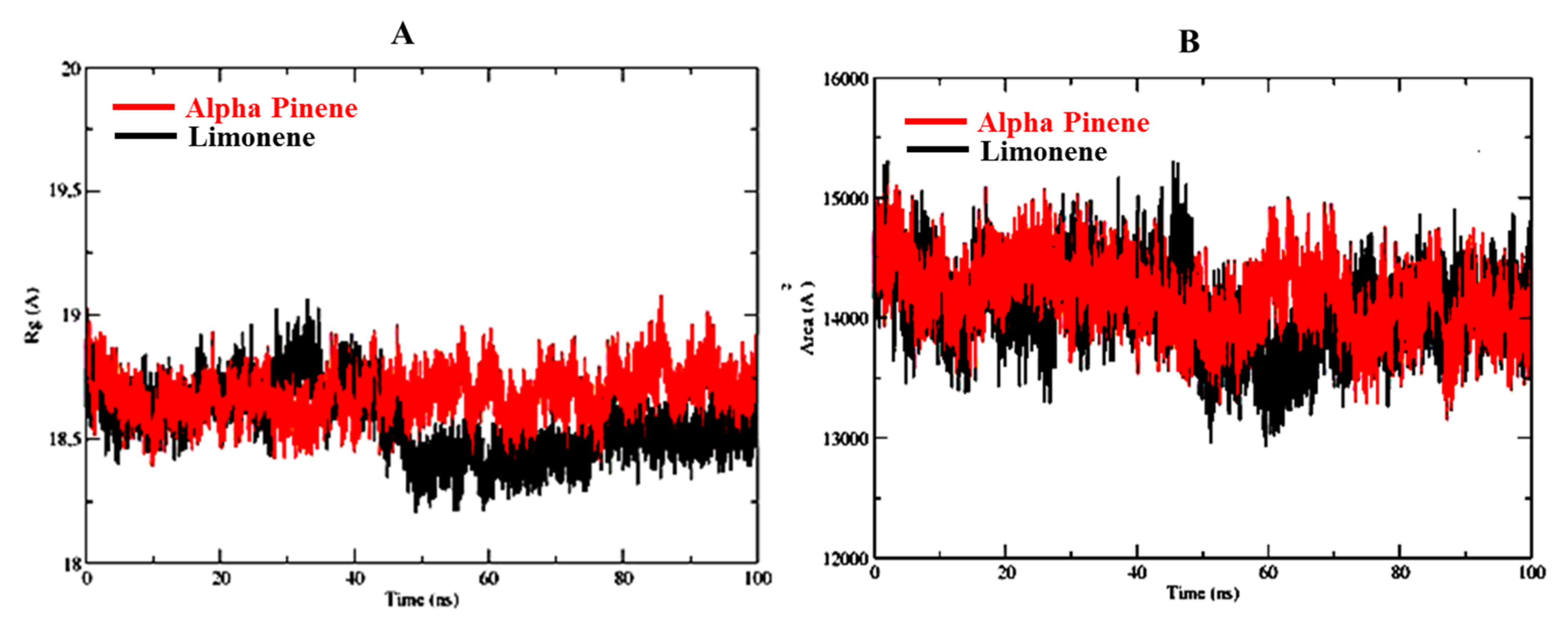
| Sr. No. | Phytoconstituent (Scientific Name) | Targeted Cancer Cell Lines |
|---|---|---|
| 1-(1-Cyanocyclohexyl) pyrrolidine | - | |
| 1. | 1,2-Dithiocane (1,2-dithiacyclooctane) | - |
| 2. | Acetic acid | Gastric (RGM1, RGK1, RGM-GFP and RGK-KO) cells [27] |
| 3. | Anisaldehyde (4-methoxybenzaldehyde) | Breast (MCF-7), epidermoid carcinoma (ME 180), liver (HepG2) cells [12] |
| 4. | Ascorbic acid | Bladder, breast, cervical, colorectal, esophageal, leukemia, lung, non-Hodgkin’s lymphoma, pancreatic, prostate, salivary gland, and stomach cancers [28] |
| 5. | Camphor | Mouse model of keratinocyte-derived skin cancer [29] |
| 6. | Carvone | Human melanoma (A375) and breast (MDA-MB468) cells [14] neuroblastoma (N2a) cells [22] |
| 7. | Chlorogenic acid | Colon, glioma, hepatic, lung cancers (Human A549-5FU, Bel-7402, CCC-HEL-1, HCT-116, HEK293T, HH, Huh7, iPS, M059J, MIHA, MRC-5, NCI-H358, NCI-H446, SK- LU-1, U87MG, WI-38; rat C6; mouse G422 cells) [15] |
| 8. | D-limonene | Human breast, colorectal, hepatic, epithelial cell carcinomas; rat and mice liver cancer, pulmonary adenoma, forestomach tumors [20] |
| 9. | Eicosamethyl-cyclodecasiloxane (Icosamethyl-cyclodecasiloxane) | Breast (MCF-7), ovary (A2780), colon (HT29) cells [30] |
| 10. | Estragole (Methyl Chavinol) | Breast (MCF-7) cells [16,31] |
| 11. | Eugenol | Breast, cervical, colon, colorectal, gastric, leukemia, lung, prostate and skin cancers [17] |
| 12. | Fenchone | Ehrlich ascites carcinoma [18] |
| 13. | Iron monocarbonyl- (1,3-butadiene-1,4-dicarbonic acid, diethyl ester) | - |
| 14. | Linoleic acid (cis-9,cis-12-Octadecadienoic acid) | Human breast, colon, colorectal carcinomas; mice colon, epidermal, hepatic, mammary, prostate and stomach carcinomas [5] |
| 15. | Margaric acid (Heptadecanoic acid) | Lung (PC-9 NSCLC) cells [9] |
| 16. | Mesitol (2,3,5-trimethyl phenol) | - |
| 17. | Methyl benzaldehyde (p-tolualdehyde) | - |
| 18. | Myrcene | Lung (A549) cells [21] |
| 19. | Myristic acid (Tetradecanoic acid) | Breast cancer [21] |
| 20. | N-valeramide | - |
| 21. | Octadecane | - |
| 22. | Oleic acid (cis-9-octadecenoic acid) | Human breast (MDA-MB-231), gastric (HGC-27) cells; tongue squamous cell carcinoma (UM1 and CAL27)) [6,7] |
| 23. | Palmitic acid (Hexadecanoic acid) | Colon (HT29), colorectal (HCT-116) [10, 11] |
| 24. | Pelargic acid (1-Octanecarboxylic acid, Nonanoic acid) | - |
| 25. | Pentyl vinyl carbinol (1-Octen-3-ol) | - |
| 26. | Petroselinic acid (6-Octadecylenic acid) | - |
| 27. | Phenyethylamine (Benzene ethanamine) | Breast (MCF-7) cells [32] |
| 28. | Piperitinone oxide | - |
| 29. | Quercetin-3-o-beta-d-glucuronide | Breast (MDA-MB-231) cells [23] |
| 30. | Stearic acid (octadecanoic acid) | Breast (MDA-MB-361, MCF-7, MDA-MB-231) cells [33] |
| 31. | Syringol (2,6-dimethoxyphenol) | - |
| 32. | Trans-anethole | Breast (MCF-7) cells; Oral (Ca9-22) [24,31,34] |
| 33. | Vinylguaiacol (2-methoxy-4-vinylphenol) | Human pancreatic (Panc-1 and SNU-213) cells [26] |
| 34. | Z,Z-heptadeca-8,11-dien-1-yl bromide | - |
| 35. | α-d-glucose | - |
| 36. | α-Pinene | Neuroblastoma (N2a) cells [22]. |
| 37. | α-terpineol | Breast (MCF-7), cervix (Hela), colorectal (HCT-8, SW620, HCT-116, HT-29), leukemia (CCRF-CEM), lymphoma (U937 GTB), myeloma (RPMI 8226), renal adenocarcinoma (drug resistant 8226/Dox40, 8226/LR5, CEMVM-1, U937-vcr, H69AR and the primary resistant ACHN) and small cell lung cancer (NCI-H69) cells [25] |
| 38. | γ-asarone | Gastric (AGS) cells [13] |
| 39. | γ-terpinene | Human prostate (LNCaP, PC-3), glioblastoma (SF-763, SF-767) cells [19] |
| Common Phytoconstituents (Scientific Name) | Energy (kcal/mol) | Inhibition Constant (Ki) | H-Bonding | Interacting Amino Acids |
|---|---|---|---|---|
| 1,2-Dithiocane (1,2-dithiacyclooctane) | −4.7 | 1.0 × 1015 | Asp 537, Asp 538, Leu 544, Asp 545 | Leu 372, Val 376, Leu 539, Leu 540, Glu 542, Met 543 |
| 1-(1-Cyanocyclohexyl) pyrrolidine | −5.8 | 1.0 × 1015 | - | Leu 346, Leu 349, Ala 350, Glu 353, Leu 387, Met 388, Leu 391, Arg 394, Phe 404 |
| Acetic acid | −3.4 | 1.0 × 1015 | Asn 455, Ser 456, Leu 511, Arg 515 | Glu 385, Ile 451, Ile 452, Ser 512 |
| Anisaldehyde (4-methoxy benzaldehyde) | −4.9 | 1.0 × 1015 | Arg 394 | Leu 346, Thr 347, Leu 349, Ala 350, Glu 353, Leu 384, Leu 387, Leu 391, Phe 404 |
| Ascorbic acid | −5.1 | 1.0 × 1015 | Glu 380, Ser 381, Ser 456, Ser 518 | Trp 383, Glu 385, Asn 519, Met 522 |
| Camphor | −5.5 | 1.0 × 1015 | - | Leu 349, leu 346, leu 391, Ala 350, Leu 384, Met 388, Leu 387, Trp 383 |
| Carvone | −5.6 | 1.0 × 1015 | - | Leu 248, Ile 424, Leu 346, Ala 350, Phe 404, Met 388, Leu 384, Leu 391, Leu 349, Arg 394, Leu 387, Glu 353 |
| Chlorogenic acid | −5.3 | 1.0 × 1015 | Ser 381, Thr 460, Ser 456, Asn 519 | Glu 523, Tyr 526, Met 522, His 377, Gly 457 |
| D-Limonene | −5.9 | 1.0 × 1015 | - | Leu 346, Leu 349, Ala 350, Glu 353, Leu 384, Leu 387, Met 388, Leu 391, Arg 394, Phe 404, Ile 424, Leu 428 |
| Eicosamethyl-cyclodecasiloxane (Icosamethyl-cyclodecasiloxane) | N/A | 1.0 × 1015 | - | - |
| Estragole | −4.9 | 1.0 × 1015 | Thr 347 | Met 343, Leu 346, Ala 350, Trp 383, Leu 384, Leu 387, Leu 525 |
| Eugenol | −5.6 | 1.0 × 1015 | - | Leu 428, Leu 387, Arg 394, Glu 353, Met 388, Ala 350, Leu 346, Leu 391, Leu 349, Ile 424, Phe 404 |
| Fenchone | −5.2 | 1.0 × 1015 | - | Leu 346, Ala 350, Glu 353 Leu 387, Met 388, Arg 394, Phe 404 |
| Linoleic acid (cis-9,cis-12-Octadecadienoic acid) | −5.5 | 1.0 × 1015 | - | Met 343, Leu 346, Leu 349, Ala 350, Met 383, Leu 384, Leu 387, Met 388, Leu 391, Arg 394, Phe 404, Met 421, Ile 424, Leu 428, Gly 521, His 524, Leu 525 |
| Margaric acid (Heptadecanoic acid) | −3.6 | 1.0 × 1015 | Asp 332, Glu 339 | Glu 330, Tyr 331, Arg 335, Pro 336, Ala 340, Ser 341, Gly 344, Asn 348 |
| Mesitol (2,3,5-trimethyl phenol) | −4.7 | 1.0 × 1015 | - | Leu 346, Leu 349, Leu 387, Glu 353, Met 522, Leu 526 |
| Methyl-chavicole | −5.2 | 1.0 × 1015 | - | Phe 404, Leu 391, Leu 349, Leu 525, Arg 394, Leu 387, Glu 353, Ala 350, Leu 346, Trp 383, Leu 384, Leu 525 |
| Methyl benzaldehyde (p-tolualdehyde) | −5.2 | 1.0 × 1015 | Arg 394 | Leu 346, Leu 349, Ala 350, Glu 353, Leu 387, Met 388, Leu 391, Phe 404 |
| Myrcene | −4.7 | 1.0 × 1015 | - | Ala 350, Leu 354, Trp 383, Leu 536, Asp 351, Met 522, Leu 525, Tyr 526 |
| Myristic acid (Tetradecanoic acid) | −4.0 | 1.0 × 1015 | Val 533 | Asn 532, Val 534, Pro 535, Leu 354, Tyr 526, Cys 530, Met 522, Leu 536, Leu 526, Trp383 |
| N-Valeramide | −4.2 | 1.0 × 1015 | Arg 394 | Met 343, Leu 346, Ala 350, Leu 391, Phe 404 |
| Octadecane | −3.8 | 1.0 × 1015 | - | Trp 383, Met 522, Leu 525, Tyr 526, Lys 529, Cys 530, Val 533, Leu 536 |
| Oleic acid (cis-9-octadecenoic acid) | −4.2 | 1.0 × 1015 | - | - |
| Palmitic acid (Hexadecanoic acid) | −4.7 | 1.0 × 1015 | Ser 381, Ser 456, Thr 460 | Glu 380, Gly 457, Glu 523, Met 522, Tyr 526 |
| Pelargic acid (1-Octanecarboxylic acid, Nonanoic acid) | −4.1 | 1.0 × 1015 | Ser 381, Thr 460, Arg 515 | Ser 456, Gly 457, Ser 518, Asn 519, Met 522 |
| Pentyl vinyl carbinol (1-Octen-3-ol) | −4.7 | 1.0 × 1015 | - | Leu 349, Ala 350, Leu 346, Leu 387, Phe 404, Glu 353, Met 388, Leu 391 |
| Petroselinic acid (6-Octadecylenic acid) | −4.2 | 1.0 × 1015 | - | Arg 515, Ser 518, Met 522, Ser 381, Asn 519, Glu 380, Thr 460, His 377, Glu 523 |
| Phenyethylamine (Benzene ethanamine) | −4.7 | 1.0 × 1015 | - | Leu 346, Thr 347, Leu 349, Ala 350, Glu 353, Leu 384, Leu 387, Met 388, Leu 391, Arg 394, Phe 404, Leu 525 |
| Piperitinone oxide | −5.8 | 1.0 × 1015 | - | Leu 346, Leu 349, Ala 350, Trp 383, Leu 384, Leu 387, Met 388, Leu 391, Arg 394, Phe 404, Ile 424, Leu 428 |
| Quercetin-3-o-beta-d-glucuronide | −5.1 | 1.0 × 1015 | Tyr 526, Cys 530 | Pro 535, Leu 525, Lys 529, Lys 531, Val 533, Asn 532, Lys 531, Met 522, Trp 383, Glu 380, Ser 537, Pro 535 |
| Stearic acid (octadecanoic acid) | −4.7 | 1.0 × 1015 | - | Arg 394, Glu 353, Leu 525, Trp 383, Leu 535, Leu 391, Leu 387, Leu 384, Ala 350, Thr 347, Leu 354, Asp 351, Leu 539, Phe 404, Met 388, Leu 346 |
| Syringol (2,6-dimethoxy phenol) | −4.7 | 1.0 × 1015 | - | Leu 346, Leu 349, Ala 350, Glu 353, Leu 384, Leu 387, Met 388, Leu 391, Phe 404, Leu 428 |
| Trans-anethole | −5.5 | 1.0 × 1015 | - | Leu 346, Leu 349, Ala 350, Glu 353, Leu 387, Leu 391Arg 394, Phe 404, Met 434, Leu 525 |
| Vinyl guaiacol (2-methoxy-4-vinylphenol) | −5.2 | 1.0 × 1015 | - | Leu 346, Leu 349, Ala 350, Glu 353, Leu 387, Met 388, Leu 391, Arg 394, Phe 404, Leu 428 |
| Z,Z-heptadeca-8,11-dien-1-yl bromide | −3.7 | 1.0 × 1015 | - | Asn 519, Glu 523, Met 522, Ser 381, Tyr 526 |
| α-d-Glucose | −5.3 | 1.0 × 1015 | Glu 380, Ser 381, Arg 515, Asn 519 | His 377, Ser 456, Gly 457, Thr 460, Ser 518, Met 522 |
| α-Pinene | −6.0 | 1.0 × 1015 | - | Leu 346, Leu 349, Ala 350, Glu 353, Leu 384, Leu 387, Met 388, Leu 391, Phe 404 |
| α-terpeneol | −5.8 | 1.0 × 1015 | - | Trp 383, Thr 347, Leu 525, Leu 346, Leu 384, Leu 387, Ala 350, Leu 349, Phe 404, Glu 353, Leu 391 |
| γ-asarone | −5.2 | 1.0 × 1015 | - | Glu 380, Ser 381, Trp 383, Tyr 526, Met 522, Ser 381, Glu 523, Asn 519, Ser 518 |
| γ-terpinene | −5.5 | 1.0 × 1015 | - | Ala 350, Leu 349, Glu 353, Arg 394, Phe 404, Leu 428, Met 421, Leu 391, Met 388, Leu 387, Ile 424, Leu 346, Leu 384 |
| Phytocompounds | Log P | Polar Surface Area (Å2) | No. of atoms | No. of Nitrogen and Oxygen | No. of -OH and -NHn | Violations | Number of rotations | MW |
|---|---|---|---|---|---|---|---|---|
| 1-2-Dithiocane | 2.75 | 0.00 | 8 | 0 | 0 | 0 | 0 | 148.30 |
| 1-Cyanocychexylpyrrolidin | −0.48 | 44.10 | 10 | 3 | 0 | 0 | 1 | 138.17 |
| Acetic acid | −0.23 | 37.30 | 4 | 2 | 1 | 0 | 0 | 60.05 |
| Anisaldehyde | 1.78 | 26.30 | 10 | 2 | 0 | 0 | 2 | 136.15 |
| Ascorbic acid | −1.40 | 107.22 | 12 | 6 | 4 | 0 | 2 | 176.12 |
| Benzeneethanamine | 0.92 | 26.02 | 9 | 1 | 2 | 0 | 2 | 121.18 |
| Camphor | 2.16 | 17.07 | 11 | 1 | 0 | 0 | 0 | 152.24 |
| Carvone | 2.51 | 17.07 | 11 | 1 | 0 | 0 | 1 | 150.22 |
| Chlorogenic acid | −0.45 | 164.74 | 25 | 9 | 6 | 1 | 5 | 354.31 |
| D-limonene | 3.62 | 0.00 | 10 | 0 | 0 | 0 | 1 | 136.24 |
| Eicosamethyl-cyclodecasiloxane | 3.66 | 92.34 | 40 | 10 | 0 | 1 | 0 | 741.55 |
| Estragole | 2.82 | 9.23 | 11 | 1 | 0 | 0 | 3 | 148.21 |
| Eugenol | 2.10 | 29.46 | 12 | 2 | 1 | 0 | 3 | 164.20 |
| Fenchone | 2.16 | 17.07 | 11 | 1 | 0 | 0 | 0 | 152.24 |
| Heptadecanoic acid | 7.56 | 37.30 | 19 | 2 | 2 | 1 | 15 | 270.46 |
| Hexadecanoic acid | 7.06 | 37.30 | 18 | 2 | 1 | 1 | 14 | 256.43 |
| Linoleic acid | 6.86 | 37.30 | 20 | 2 | 1 | 1 | 14 | 280.45 |
| Methylchavicole | 2.82 | 9.23 | 11 | 1 | 0 | 0 | 3 | 148.21 |
| Myrcene | 3.99 | 0.00 | 10 | 0 | 0 | 0 | 4 | 136.24 |
| Myristic acid | 6.05 | 37.30 | 16 | 2 | 1 | 1 | 12 | 228.38 |
| Octadecenoic acid | 7.82 | 37.30 | 20 | 2 | 1 | 1 | 15 | 282.47 |
| Pelargic acid | 3.52 | 37.30 | 11 | 2 | 1 | 0 | 7 | 158.24 |
| Petroselinic acid | 7.58 | 37.30 | 20 | 2 | 1 | 1 | 15 | 282.47 |
| Piperitinone oxide | 1.76 | 29.60 | 122 | 0 | 0 | 0 | 0 | 166.22 |
| p-Tolualdehyde | 2.18 | 17.07 | 9 | 1 | 0 | 0 | 1 | 120.15 |
| Quercetin-3-O-beta-D-glucuronide | −0.49 | 227.57 | 34 | 13 | 8 | 2 | 4 | 478.36 |
| Stearic acid | 8.07 | 37.30 | 20 | 2 | 1 | 1 | 16 | 284.48 |
| Syringol | 1.34 | 38.70 | 11 | 3 | 1 | 0 | 2 | 154.16 |
| Trans-anethole | 3.10 | 9.23 | 11 | 1 | 0 | 0 | 2 | 148.21 |
| Vinylguaiacol | 2.15 | 29.46 | 11 | 2 | 1 | 0 | 2 | 150.18 |
| Z,Z-Heptadeca-8,11-dien-1-yl bromide | 6.93 | 17.07 | 18 | 1 | 0 | 1 | 13 | 250.43 |
| α-d-Glucose | −2.64 | 110.37 | 12 | 6 | 5 | 0 | 1 | 180.16 |
| α-Pinene | 3.54 | 0.00 | 10 | 0 | 0 | 0 | 0 | 136.24 |
| α-Terpineol | 2.60 | 20.23 | 11 | 1 | 1 | 0 | 1 | 154.25 |
| Pentyl vinyl carbinol (1-Octen-3-ol) | 2.76 | 20.23 | 9 | 1 | 1 | 0 | 5 | 128.22 |
| γ-Asarone | 2.39 | 27.70 | 15 | 3 | 0 | 0 | 5 | 208.26 |
| γ-Terpinene | 3.36 | 0.00 | 10 | 0 | 0 | 0 | 1 | 136.24 |
| Phytocompounds | Protox II | |||||
|---|---|---|---|---|---|---|
| LD50, (mg/kg) | Hepatotoxicity | Carcinogenicity | Immunotoxicity | Mutagenicity | Cytotoxicity | |
| 1-2-Dithiocane | 620 (Class 4) | Inactive | Inactive | Inactive | Inactive | Inactive |
| 1-Cyanocychexylpyrrolidin | 1650 (Class 4) | Inactive | Inactive | Inactive | Inactive | Inactive |
| Acetic acid | 333 (Class 1) | Inactive | Inactive | Inactive | Inactive | Inactive |
| Anisaldehyde | 1550 (Class 4) | Inactive | Active | Inactive | Inactive | Inactive |
| Ascorbic acid | 3767 (Class 5) | Inactive | Inactive | Inactive | Inactive | Inactive |
| Benzeneethanamine | 400 (Class 4) | Inactive | Inactive | Inactive | Inactive | Inactive |
| Camphor | 775 (Class 4) | Inactive | Inactive | Inactive | Inactive | Inactive |
| Carvone | 1640 (Class 4) | Inactive | Inactive | Inactive | Inactive | Inactive |
| Chlorogenic acid | 5000 (Class 5) | Inactive | Inactive | Active | Inactive | Inactive |
| D-limonene | 500 (Class 4) | Inactive | Inactive | Inactive | Inactive | Inactive |
| Eicosamethyl-cyclodecasiloxane | 1540 (Class 4) | Inactive | Inactive | Inactive | Inactive | Inactive |
| Estragole | 1203 (Class 4) | Inactive | Active | Inactive | Inactive | Inactive |
| Eugenol | 1930 (Class 4) | Inactive | Inactive | Inactive | Inactive | Inactive |
| Fenchone | 775 (Class 4) | Inactive | Inactive | Inactive | Inactive | Inactive |
| Linoleic acid | 10000 (Class 6) | Inactive | Inactive | Inactive | Inactive | Inactive |
| Margaric acid (Heptadecanoic acid) | 900 (Class 4) | Inactive | Inactive | Inactive | Inactive | Inactive |
| Methyl benzaldehyde (p-Tolualdehyde) | 1600 (Class 4) | Inactive | Active | Inactive | Inactive | Inactive |
| Methyl chavicole | 1230 (Class 4) | Inactive | Active | Inactive | Inactive | Inactive |
| Myrcene | 5000 (Class 5) | Inactive | Inactive | Inactive | Inactive | Inactive |
| Myristic acid | 900 (Class 4) | Inactive | Inactive | Inactive | Inactive | Inactive |
| N-valeramide | 400 (Class 4) | Inactive | Inactive | Inactive | Inactive | Inactive |
| Octadecane | 750 (Class 3) | Inactive | Inactive | Inactive | Inactive | Inactive |
| Octadecenoic acid | 1925 (Class 4) | Active | Inactive | Inactive | Inactive | Inactive |
| Pelargic acid | 900 (Class 4) | Inactive | Inactive | Inactive | Inactive | Inactive |
| Pentyl vinyl carbinol (1-octen-3-ol) | 340 (Class 4) | Inactive | Inactive | Inactive | Inactive | Inactive |
| Petroselinic acid | 48 (Class 2) | Inactive | Inactive | Inactive | Inactive | Inactive |
| Piperitinone oxide | 2500 (Class 5) | Inactive | Inactive | Inactive | Inactive | Inactive |
| Quercetin-3-o-beta-d-glucuronide | 5000 (Class 5) | Inactive | Active | Active | Inactive | Inactive |
| Stearic acid | 950 (Class 4) | Inactive | Inactive | Inactive | Inactive | Inactive |
| Syringol | 550 (Class 4) | Inactive | Inactive | Inactive | Inactive | Inactive |
| Trans-anethole | 150 (Class 3) | Inactive | Active | Inactive | Inactive | Inactive |
| Vinylguaiacol | 1560 (Class 4) | Inactive | Inactive | Active | Inactive | Inactive |
| Z,Z-Heptadeca-8,11-dien-1-yl bromide | 5000 (Class 5) | Inactive | Inactive | Inactive | Inactive | Inactive |
| α-d-Glucose | 1190 (Class 4) | Active | Inactive | Active | Inactive | Inactive |
| α-Pinene | 3700 (Class 5) | Inactive | Inactive | Inactive | Inactive | Inactive |
| α-Terpeneol | 2830 (Class 5) | Inactive | Inactive | Inactive | Inactive | Inactive |
| γ-Asarone | 1000 (Class 4) | Inactive | Active | Inactive | Active | Inactive |
| γ-Terpinene | 2500 (Class 5) | Inactive | Inactive | Inactive | Inactive | Inactive |
Publisher’s Note: MDPI stays neutral with regard to jurisdictional claims in published maps and institutional affiliations. |
© 2022 by the authors. Licensee MDPI, Basel, Switzerland. This article is an open access article distributed under the terms and conditions of the Creative Commons Attribution (CC BY) license (https://creativecommons.org/licenses/by/4.0/).
Share and Cite
Kaur, B.; Rolta, R.; Salaria, D.; Kumar, B.; Fadare, O.A.; da Costa, R.A.; Ahmad, A.; Al-Rawi, M.B.A.; Raish, M.; Rather, I.A. An In Silico Investigation to Explore Anti-Cancer Potential of Foeniculum vulgare Mill. Phytoconstituents for the Management of Human Breast Cancer. Molecules 2022, 27, 4077. https://doi.org/10.3390/molecules27134077
Kaur B, Rolta R, Salaria D, Kumar B, Fadare OA, da Costa RA, Ahmad A, Al-Rawi MBA, Raish M, Rather IA. An In Silico Investigation to Explore Anti-Cancer Potential of Foeniculum vulgare Mill. Phytoconstituents for the Management of Human Breast Cancer. Molecules. 2022; 27(13):4077. https://doi.org/10.3390/molecules27134077
Chicago/Turabian StyleKaur, Baljinder, Rajan Rolta, Deeksha Salaria, Balvir Kumar, Olatomide A. Fadare, Renato Araujo da Costa, Ajaz Ahmad, Mahmood Basil A. Al-Rawi, Mohammad Raish, and Irfan A. Rather. 2022. "An In Silico Investigation to Explore Anti-Cancer Potential of Foeniculum vulgare Mill. Phytoconstituents for the Management of Human Breast Cancer" Molecules 27, no. 13: 4077. https://doi.org/10.3390/molecules27134077
APA StyleKaur, B., Rolta, R., Salaria, D., Kumar, B., Fadare, O. A., da Costa, R. A., Ahmad, A., Al-Rawi, M. B. A., Raish, M., & Rather, I. A. (2022). An In Silico Investigation to Explore Anti-Cancer Potential of Foeniculum vulgare Mill. Phytoconstituents for the Management of Human Breast Cancer. Molecules, 27(13), 4077. https://doi.org/10.3390/molecules27134077








